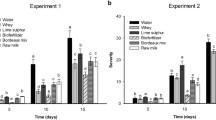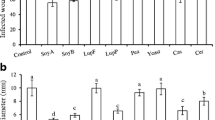Abstract
Grapevine powdery mildew, caused by the fungus Erysiphe (Uncinula) necator, is a major disease affecting grape yield and quality worldwide. In conventional vineyards, the disease is controlled mainly by regular applications of sulfur and synthetic fungicides and, in organic agriculture, by sulfur and botanical and mineral oils. Research has identified milk and whey as potential replacements for synthetic fungicides and sulfur in the control of powdery mildew. Electron spin resonance and scanning electron microscopy were used to investigate the possible mode or modes of action of milk and whey in the control of powdery mildew. Electron spin resonance experiments showed that various components of milk produced oxygen radicals in natural light, which may have contributed to the reduction of severity of powdery mildew on treated leaves. Milk and whey caused the hyphae of E. necator to collapse and damaged conidia within 24 h of treatment. Hydrogen peroxide, applied as a source of free radicals, also caused collapse of the hyphae of E. necator but did not damage conidia, and appeared to stimulate germination. Lactoferrin (an antimicrobial component of milk) ruptured conidia, but damage to hyphae was not evident until 48 h after treatment. The results support the hypothesis that free radical production and the action of lactoferrin are associated with the control of powdery mildew by milk.
Similar content being viewed by others
References
Batish VK, Chander H, Zumdegni KC, Bhatia KL, Singh RS (1988) Antimicrobial activity of lactoferrin against some common food-borne pathogenic organisms. Australian Journal of Dairy Technology 42, 16–18.
Bettiol W (1999) Effectiveness of cow’s milk against zucchini squash powdery mildew (Sphaerotheca fuliginea) in greenhouse conditions. Crop Protection (Guildford, Surrey) 18, 489–492. doi: 10.1016/S0261-2194(99)00046-0
Chellemi DO, Marois JJ (1992) Influence of leaf removal, fungicide applications and fruit maturity on incidence and severity of grape powdery mildew. American Journal of Enology and Viticulture 43, 53–57.
Crisp P, Scott ES, Wicks TJ (2000) Towards biological control of powdery mildewof grapevine in cool climate viticulture in Australia. Australian Grapegrower and Winemaker 440, 27–30.
Crisp P, Scott ES, Wicks TJ (2002) Novel control of grapevine powdery mildew. In ‘Proceedings of the 4th InternationalWorkshop on Grapevine Powdery and Downy Mildew’. (Eds DM Gadoury, C Gessler, G Grove, WD Gubler, GK Hill, HH Kassemeyer, WK Kast, J Rumbolz, ES Scott) pp. 78–79. (University of California: Davis, CA)
Crisp P, Scott ES, Wicks TJ (2003) Mode of action of potential novel controls of grapevine powdery mildew, Uncinula necator. In ‘Proceedings of the 2nd National Organic Conference, Adelaide, Australia’. pp 133–136.
Evans KJ, Whisson DL, Scott ES (1996) An experimental system for characterising isolates of Uncinula necator. Mycological Research 100, 675–680.
Hoffman ME, Meneghini R (1979) DNA strand breaks in mammalian cells exposed to light in the presence of riboflavin and tryptophan. Photochemistry and Photobiology 29, 299–303.
Imlay JA, Lin S (1988) DNA damage and oxygen radical toxicity. Science 240, 1302–1309.
Jordan CM, Wakeman RJ, DeVay JE (1992) Toxicity of free riboflavin and methionine-riboflavin solutions to Phytophthora infestans and the reduction of potato late blight disease. Canadian Journal of Microbiology 38, 1108–1111.
Kanyshkova TG, Buneva VN, Nevinsky GA (2000) Lactoferrin and its biological functions. Biochemistry 66, 1–7.
Korycha-Dahl M, Richardson T (1978) Photogeneration of superoxide anion in serum of bovine milk and in model systems containing riboflavin and amino acids. Journal of Dairy Science 61, 400–407.
Kuipers ME, De Vries HG, Eikelboom MC, Meijer DKF, Swart PJ (1999) Synergistic fungistatic effects of lactoferrin in combination with antifungal drugs against clinical Candida isolates. Antimicrobial Agents and Chemotherapy 43, 2635–2641.
Magarey PA, Gadoury DM, Emmett RW, Biggins LT, Clark K, Watchel MF, Wicks TJ, Seem RC (1997) Cleistothecia of Uncinula necator in Australia. Viticultural and Enological Science 52, 210–218.
Modler HW, Schroder KE, Pratt CE (1998) Inhibition of bacterial growth in whey by the activation of lactoperoxidase. Bulletin of the International Dairy Federation 332, 32–46.
Ough CS, Berg HW (1979) Powdery mildew sensory effect on wine. American Journal of Enology and Viticulture 30, 321.
Riechel P, Weiss T, Weiss M, Ulber H, Buchholz H, Scheper T (1998) Determination of the minor whey protein bovine lactoferrin in cheese whey concentrates with capillary electrophoresis. Journal of Chromatography A 817, 187–193. doi: 10.1016/S0021-9673(98)00445-2
Sallmann F, Baveye-Descamps S, Pattus F, Salmon V, Branza N, Spik G, Legrande D (1999) Porins OmpC and PhoE of Escherichia coli as specific cell-surface targets of human lactoferrin, binding characteristics and biological effects. Journal of Biological Chemistry 274, 16107–16114. doi: 10.1074/jbc.274.23.16107
Samaranayake YH, Samaranayake LP, Pow EHN, Beena VT, Yeung KWS (2001) Antifungal effects of lysozyme and lactoferrin against genetically similar, sequential Candida albicans isolates from a human immunodeficiency virus-infected southern Chinese cohort. Journal of Clinical Microbiology 39, 3296–3302. doi: 10.1128/JCM.39.9.3296-3302.2001
Tzeng DD, DeVay JE (1984) Ethylene production and toxigenicity of methionine and its derivatives with riboflavin in cultures of Verticillium, Fusarium and Colletotrichum species exposed to light. Physiological Plant Pathology 62, 545–552. doi: 10.1111/j.1399-3054.1984.tb02797.x
Tzeng DD, DeVay JE (1989) Biocidal activity of mixtures of methionine and riboflavin against plant pathogenic fungi and bacteria and possible modes of action. Mycologia 81, 402–412.
Author information
Authors and Affiliations
Corresponding author
Rights and permissions
About this article
Cite this article
Crisp, P., Wicks, T.J., Troup, G. et al. Mode of action of milk and whey in the control of grapevine powdery mildew. Australasian Plant Pathology 35, 487–493 (2006). https://doi.org/10.1071/AP06052
Received:
Accepted:
Issue Date:
DOI: https://doi.org/10.1071/AP06052




